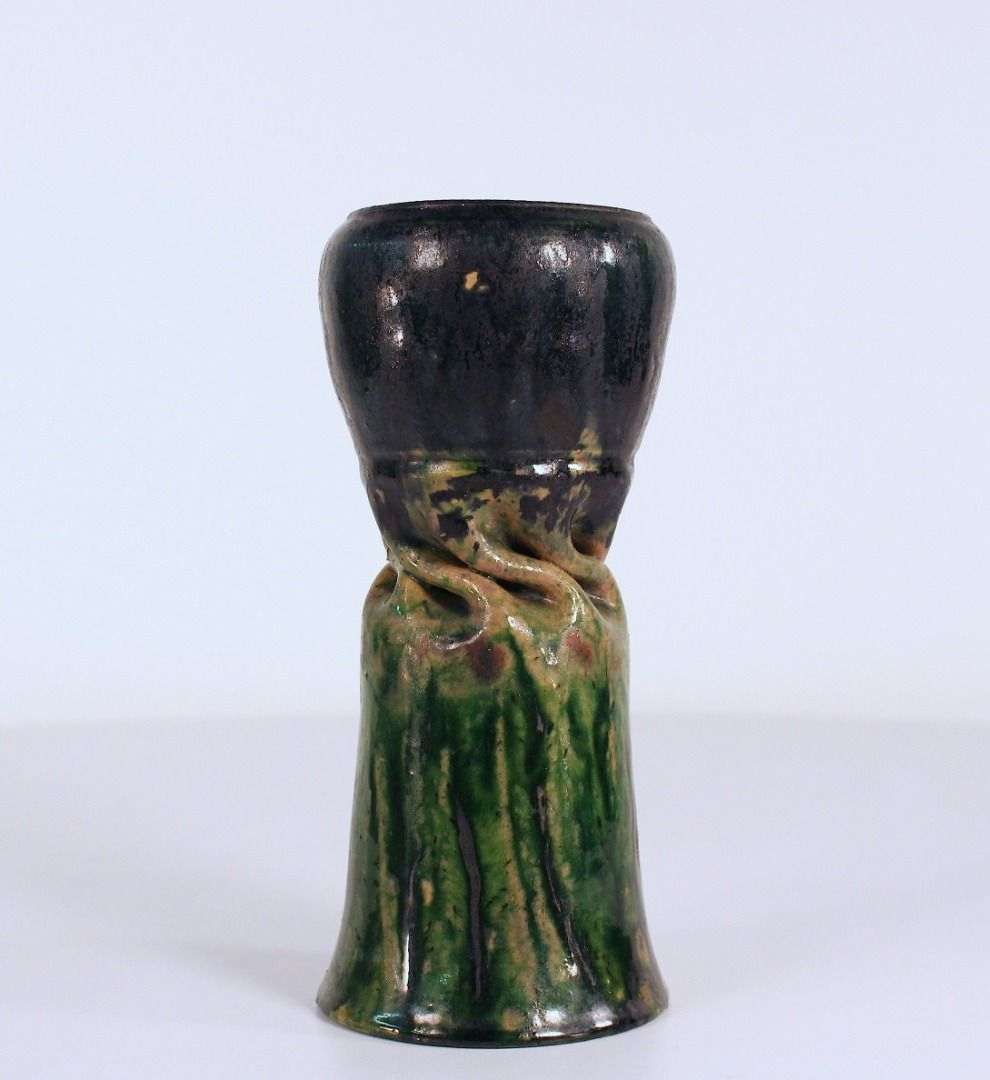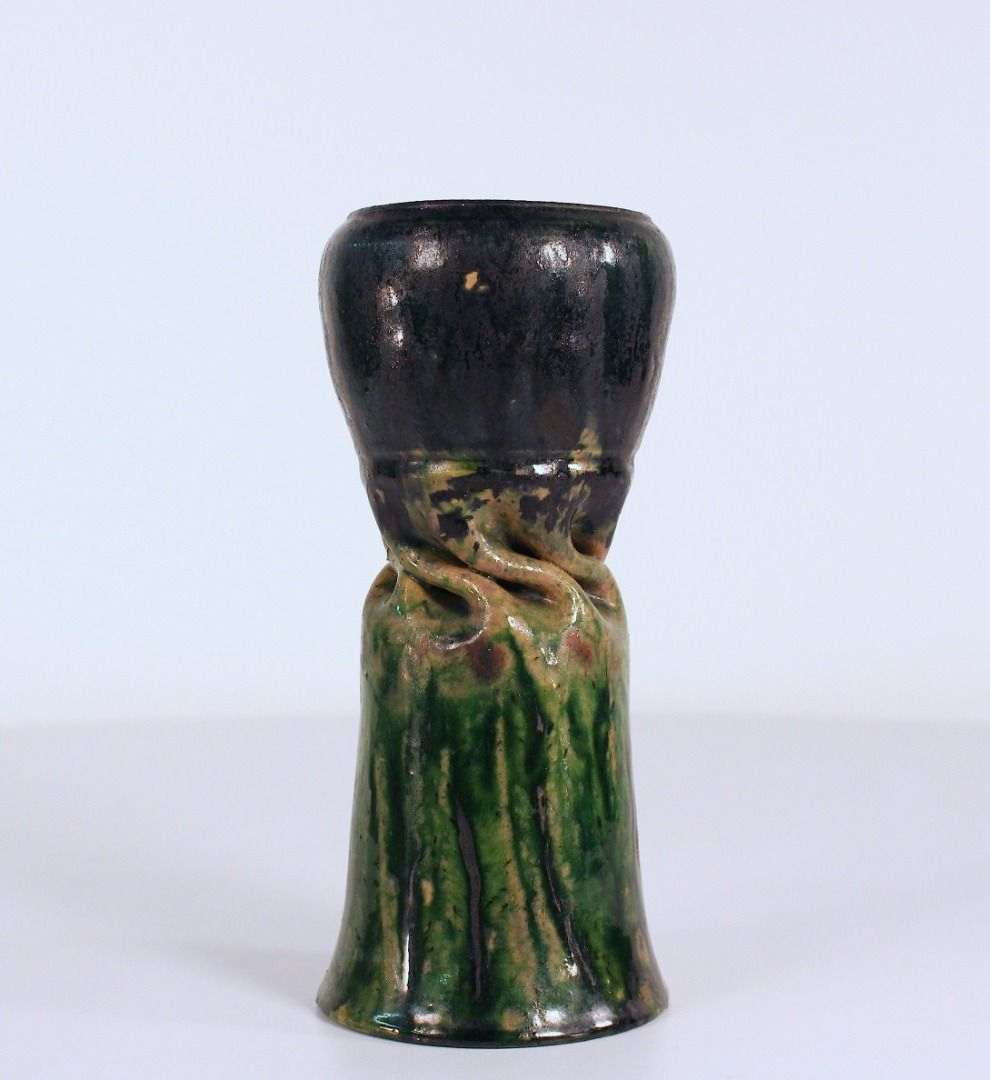
George Ohr (1857-1918) described himself boldly and provocatively: “Unequaled. Unrivaled. Undisputed. The Greatest Art Potter on Earth.” While “the Greatest Art Potter on Earth” never received the traction that Ohr desired, he was known by another title that lasted well past his death: “the Mad Potter of Biloxi.” Born on July 12, 1857 to a blacksmith and his wife, Ohr was the second of five children. From the start, Ohr felt like the black sheep of his family. He described his childhood as living with “three hens, one rooster, and a duck.” After several years experimenting with various apprenticeships and professions, including one season as a sailor at sea, Ohr received a letter from a childhood friend inviting him to New Orleans to learn pottery. Enthusiastic at the chance to leave Biloxi for New Orleans, Ohr hopped freight trains in order to join his friend, Joseph F. Meyer, at his potting studio. Meyer, Ohr’s senior by nine years, focused on making practical crockery. Ohr loved working with clay and threw himself into the practice as he learned under his amiable friend. After mastering clay under Meyer’s benign guidance, Ohr left New Orleans to take a meandering two-year trip across the United States to see studios run by other potters. He eventually returned to Biloxi, and began constructing his own studio in 1883. Ohr built his studio from the ground up, harvesting materials from the nearby landscape. He fabricated all the iron necessary for his studio himself, including his potter’s wheel, though he did steal many tools from his father. Ohr initially made functional works such as flue pipes, water jars, flowerpots, planters, and pitchers, which he would sell door to door in a pushcart. Ohr met moderate success by peddling his ceramics, but he desired recognition for his artistic skill. He used his modest profits to pack and ship nearly 600 pots to the Cotton Centennial Exposition, the 1885 World’s Fair in New Orleans. This exposition would be ruinous for Ohr as the same people he had paid to ship his pottery ran off with not just his ceramics, but also his exhibition stand. His life’s work and wages stolen, Ohr had to begin again. Ohr rebuilt his new workshop on his father’s land, naming the new studio Biloxi Art and Novelty Pottery. It is notable that Ohr embraced the title of “art pottery,” and even proclaimed himself an “art potter” in 1898, as it separated him from the functional tutelage of Meyer and Ohr’s early works. Art pottery is made from an artist’s motivation regardless of utility, while potters like Meyer considered functionality a key part of their designs. In proclaiming himself an art potter, Ohr brazenly rejected not just his training, but also the tastes of his buying public.
Ohr has posthumously gained fame for his deft manipulation of clay. As seen in Vase, Ohr threw incredibly thin forms, which he would twist, dent, crinkle, crush, and fold. The vase is eggshell thin, and boldly projects Ohr’s use of mottled, rich glazes and skilled throwing techniques. The vase twists at the middle, the clay folded in on itself as though it were cloth. Ohr splashed the bottom of the vase in a dripping green glaze, while the top is a rich cobalt blue. This experimentation coincided with Ohr’s embrace of his eccentric persona. By the end of the nineteenth century, Biloxi became a resort city, and Ohr leveraged his unique looks, boisterous boasts, and decidedly un-Victorian pottery to turn Biloxi Art and Novelty Pottery—later Pot-Ohr-E—into a tourist stop. Ohr grew out his hair and moustache, which he styled to turn the heads of visiting vacationers. The theatrical displays helped sell Ohr to the public, which was necessary as he loathed selling his wares. Ohr claimed to view his pots as members of his family, calling them his “mud babies.” This protective nature is partially explained by a second Ohr calamity where his studio burned down in 1894. Ohr mourned his “killed babies,” and salvaged what he could. Never one to give up, Ohr rebuilt his studio, now named Biloxi Art Pottery Unlimited. This workshop is where Ohr proudly proclaimed to be the greatest art potter on earth, though he conceded that some saw him as a “crank.” While people purchased his wares, Ohr never achieved financial, critical, or commercial success during his lifetime. In despair, he buried large piles of his “mud babies,” hoping for a future that would understand his artistic vision. Today his work is prized as some of the most important ceramics made at the turn of the century. Vase is currently on display in Renegades and Reformers: American Art Pottery, on view through October 18, 2020. —Kelli Fisher, Curatorial InternImage caption: George Ohr, Vase, ca. 1900, earthenware, 6¾ x 3¼ inches, Everson Museum of Art; Museum purchase, 76.60 Sources:1. Campbell, Gordon. “Ohr, George E.” Grove Art Online. 25 Jul. 2013; Accessed 9 Oct. 2020. https://www-oxfordartonline-com.libezproxy2.syr.edu/groveart/view/10.1093/gao/9781884446054.001.0001/oao-9781884446054-e-7002073294.2. Hecht, Eugene. “The Times and Life of G.E. Ohr.” In The Mad Potter of Biloxi: The Art & Life of George E. Ohr, edited by Constance Herndon, 9-64. New York: Abbeville Press, 1989


